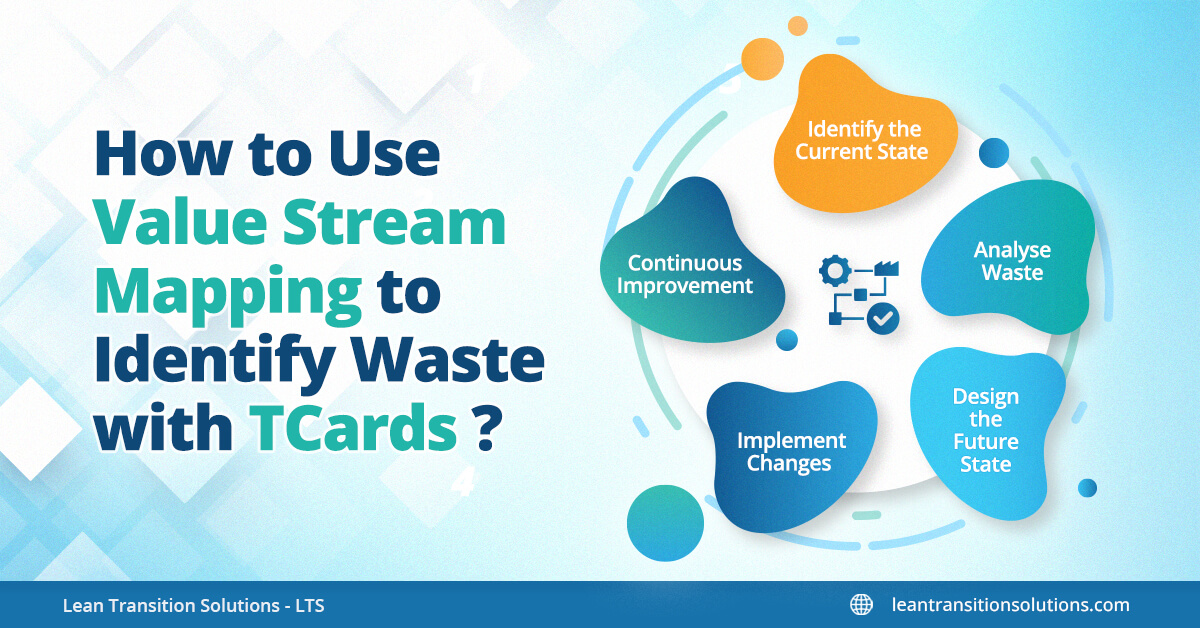How to Use Value Stream Mapping to Identify Waste and How TCards Can Help You Eliminate It?
February 14, 2025
What does pepper have to do with your cake? A pinch of pepper can elevate your cake to a whole new level. Similarly, something that initially seems to have no value to your end product might unexpectedly contribute significantly. But how do you identify whether a resource has value to offer? Relying solely on the end result can be painstaking and may lead you down the wrong path, where you risk eliminating a resource or entity that could generate value in the long run.
What if you could visualise the flow of all resources, processes, and entities that contribute to your overall product lifecycle? With digital tools like workflow management software and TCard systems , you can harness the power of Value Stream Mapping (VSM) to identify waste and enhance productivity. Curious to uncover the intricate details of your process chain and see exactly what’s helping or hindering you? Read on.
What if you could visualise the flow of all resources, processes, and entities that contribute to your overall product lifecycle? With digital tools like workflow management software and TCard systems , you can harness the power of Value Stream Mapping (VSM) to identify waste and enhance productivity. Curious to uncover the intricate details of your process chain and see exactly what’s helping or hindering you? Read on.
How to Use Value Stream Mapping to Identify Waste?
Remember those “match the following” tests from school? Value Stream Mapping is similar—only this time, you’re matching value to people and processes. Anything that doesn’t have a match is identified as waste and left out of the value stream. Little did we know those exercises were preparing us for real-life challenges, like clearing the clutter in our workflows. Are you wondering how to identify and eliminate lean wastes in your organisation?
In essence, Value Stream Mapping is about identifying what generates value and what doesn’t. Attempting this with pen and paper can lead to long hours, missed steps, and calculation errors. This is where integrated platforms like TCard come in, offering clarity and transparency by converging data from cross-departmental operations. With TCard, you can visualise task configurations, project progress, and resource utilisation across your organisation. Let’s explore how TCards enable Value Stream Mapping at every stage. Kickstart real-time workflow monitoring and workflow visualisation with TCards.
In essence, Value Stream Mapping is about identifying what generates value and what doesn’t. Attempting this with pen and paper can lead to long hours, missed steps, and calculation errors. This is where integrated platforms like TCard come in, offering clarity and transparency by converging data from cross-departmental operations. With TCard, you can visualise task configurations, project progress, and resource utilisation across your organisation. Let’s explore how TCards enable Value Stream Mapping at every stage. Kickstart real-time workflow monitoring and workflow visualisation with TCards.
Steps to Implement Value Stream Mapping with TCards
Value Stream Mapping, a Lean management tool, visualises the flow of materials, information, and processes needed to deliver a product or service. By identifying inefficiencies like delays, defects, or overproduction, VSM helps organisations eliminate waste and improve efficiency. Start eliminating bottlenecks with value stream mapping and TCards. TCard systems are value stream mapping tools for identifying bottlenecks and waste. Here’s how we are simplifying value stream mapping with TCard features:
1. Identify the Current State:
● Challenge: Mapping the existing workflow is time-intensive and prone to oversight.
➤ TCard Core Feature: Visual task tracking boards enable teams to document every step of the current process clearly. Colour-coded cards categorise tasks by priority or status, making it easier to visualise workflows.
Example: In a production line, TCards can display each stage, helping teams spot bottlenecks like excess work piling up at one point.
2. Analyse Waste:
● Challenge: Identifying inefficiencies requires detailed insights.
➤ TCard Core Feature: A centralised dashboard highlights bottlenecks by tracking stalled or overdue tasks, while historical data reveals redundant steps.
Example: Supply chain teams can identify delays by analysing TCard logs to spot recurring slow points.
3. Design the Future State:
● Challenge: Creating an optimised process requires flexibility.
➤ TCard Core Feature: Drag-and-drop functionality and custom templates allow users to simulate improved workflows before implementation.
Example: Teams can test new task sequences on TCards, adjusting until the most efficient path emerges.
4. Implement Changes:
● Challenge: Transitioning to a new workflow demands seamless coordination.
➤ TCard Core Feature: Real-time updates and notifications ensure everyone is aligned, while task assignments clarify responsibilities.
Example: During a workflow overhaul, TCards notify team members of new tasks, ensuring no one is left in the dark.
5. Continuous Improvement:
● Challenge: Maintaining and refining workflows requires consistent monitoring.
➤ TCard Core Feature: Advanced reporting provides actionable insights on task completion times and resource usage, supporting ongoing refinement.
Example: Teams can review TCard analytics to implement iterative improvements, embodying Lean’s Kaizen principle. Want to know how to do a Kaizen event?
1. Identify the Current State:
● Challenge: Mapping the existing workflow is time-intensive and prone to oversight.
➤ TCard Core Feature: Visual task tracking boards enable teams to document every step of the current process clearly. Colour-coded cards categorise tasks by priority or status, making it easier to visualise workflows.
Example: In a production line, TCards can display each stage, helping teams spot bottlenecks like excess work piling up at one point.
2. Analyse Waste:
● Challenge: Identifying inefficiencies requires detailed insights.
➤ TCard Core Feature: A centralised dashboard highlights bottlenecks by tracking stalled or overdue tasks, while historical data reveals redundant steps.
Example: Supply chain teams can identify delays by analysing TCard logs to spot recurring slow points.
3. Design the Future State:
● Challenge: Creating an optimised process requires flexibility.
➤ TCard Core Feature: Drag-and-drop functionality and custom templates allow users to simulate improved workflows before implementation.
Example: Teams can test new task sequences on TCards, adjusting until the most efficient path emerges.
4. Implement Changes:
● Challenge: Transitioning to a new workflow demands seamless coordination.
➤ TCard Core Feature: Real-time updates and notifications ensure everyone is aligned, while task assignments clarify responsibilities.
Example: During a workflow overhaul, TCards notify team members of new tasks, ensuring no one is left in the dark.
5. Continuous Improvement:
● Challenge: Maintaining and refining workflows requires consistent monitoring.
➤ TCard Core Feature: Advanced reporting provides actionable insights on task completion times and resource usage, supporting ongoing refinement.
Example: Teams can review TCard analytics to implement iterative improvements, embodying Lean’s Kaizen principle. Want to know how to do a Kaizen event?
Benefits of Using TCard in Value Stream Mapping (VSM)
1. Visual Clarity:
TCard provides a clear, intuitive view of workflows. Teams can quickly identify bottlenecks and stalled tasks, ensuring everyone understands the process without additional explanations.
Example: In manufacturing, TCards highlight stages where work accumulates, helping in bottleneck analysis and process efficiency.
2. Customisation:
Tailor TCards to fit your unique workflows with editable boards and templates. Colour-coded tasks and flexible designs allow full adaptability.
Example: Healthcare teams use TCards to track patient care, from diagnosis to discharge, ensuring the system fits their precise needs.
3. Real-Time Monitoring:
Stay updated with real-time task statuses and automated alerts, reducing delays and boosting accountability.
Example: Logistics teams can track shipments using TCards, updating statuses like “In Transit” or “Delivered” instantly.
4. Ease of Use:
TCard’s user-friendly design simplifies complex processes. With intuitive drag-and-drop functionality, even teams new to VSM can adapt quickly.
Example: Construction teams use TCards to manage materials and inspections without needing extensive training.
TCard provides a clear, intuitive view of workflows. Teams can quickly identify bottlenecks and stalled tasks, ensuring everyone understands the process without additional explanations.
Example: In manufacturing, TCards highlight stages where work accumulates, helping in bottleneck analysis and process efficiency.
2. Customisation:
Tailor TCards to fit your unique workflows with editable boards and templates. Colour-coded tasks and flexible designs allow full adaptability.
Example: Healthcare teams use TCards to track patient care, from diagnosis to discharge, ensuring the system fits their precise needs.
3. Real-Time Monitoring:
Stay updated with real-time task statuses and automated alerts, reducing delays and boosting accountability.
Example: Logistics teams can track shipments using TCards, updating statuses like “In Transit” or “Delivered” instantly.
4. Ease of Use:
TCard’s user-friendly design simplifies complex processes. With intuitive drag-and-drop functionality, even teams new to VSM can adapt quickly.
Example: Construction teams use TCards to manage materials and inspections without needing extensive training.
Streamline Your Workflow and Eliminate Waste with TCards Today!
Ready to revolutionise your processes? By combining the powerful insights of Value Stream Mapping with the intuitive features of TCards, you can eliminate inefficiencies and optimise workflows with ease. TCards offer a straightforward, effective way to track tasks, visualise bottlenecks, and continuously improve—all in one place. Don’t let inefficiencies hold you back—unlock your team’s full potential with TCards today!
FAQs
1. What is value stream mapping (VSM)?
Value stream mapping (VSM) is a lean management tool used to visualise, analyse, and improve processes by identifying waste, inefficiencies, and bottlenecks in a workflow. It provides a clear picture of how value flows through the system and highlights areas for improvement.
2. How does value stream mapping help identify waste?
VSM helps identify waste by mapping the entire process from start to finish, highlighting non-value-adding steps, delays, overproduction, defects, unnecessary movement, and underutilised resources. These insights enable teams to take targeted actions to streamline operations.
3. What are TCards, and how do they work?
TCards are a visual management tool that represents tasks or activities on cards. These cards are arranged on a board to track progress, manage workloads, and streamline workflows. TCards offer a simple yet effective way to monitor and organise tasks in real-time.
4. How can TCards support waste elimination identified through VSM?
TCards can help eliminate waste by enabling teams to visualise and prioritise tasks, ensuring smooth workflows. By addressing bottlenecks, reducing delays, and fostering better communication, TCards align with the improvements highlighted by value stream mapping.
5. What industries can benefit from using VSM and TCards together?
Industries such as manufacturing, healthcare, logistics, software development, and any process-driven businesses can benefit from using VSM and TCards. Together, they enhance operational efficiency, reduce waste, and promote lean practices across various sectors.
Value stream mapping (VSM) is a lean management tool used to visualise, analyse, and improve processes by identifying waste, inefficiencies, and bottlenecks in a workflow. It provides a clear picture of how value flows through the system and highlights areas for improvement.
2. How does value stream mapping help identify waste?
VSM helps identify waste by mapping the entire process from start to finish, highlighting non-value-adding steps, delays, overproduction, defects, unnecessary movement, and underutilised resources. These insights enable teams to take targeted actions to streamline operations.
3. What are TCards, and how do they work?
TCards are a visual management tool that represents tasks or activities on cards. These cards are arranged on a board to track progress, manage workloads, and streamline workflows. TCards offer a simple yet effective way to monitor and organise tasks in real-time.
4. How can TCards support waste elimination identified through VSM?
TCards can help eliminate waste by enabling teams to visualise and prioritise tasks, ensuring smooth workflows. By addressing bottlenecks, reducing delays, and fostering better communication, TCards align with the improvements highlighted by value stream mapping.
5. What industries can benefit from using VSM and TCards together?
Industries such as manufacturing, healthcare, logistics, software development, and any process-driven businesses can benefit from using VSM and TCards. Together, they enhance operational efficiency, reduce waste, and promote lean practices across various sectors.
